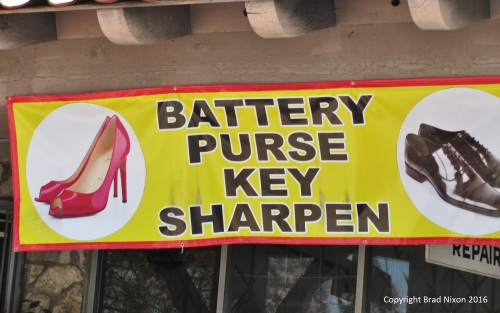English can be a frustratingly difficult language to learn. Just when you think you’ve got something nailed down — how to form the past tense of a verb or how to indicate there’s more than one of something, to name just two examples — there’s suddenly one of those exceptions.
Plurals are a perfect example. I formed the plural of “plural” by adding an “s.” But when I talk about more than one “s” — “esses” —I have to add “es.” Who decided that? the new speaker asks. Then, some words keep their original plural form in the language from which we borrowed them — octopus/octopi, cactus/cacti etc. Even more puzzling, some words change their form: man/men, woman/women. Who can figure that out? Some words don’t get anything. One deer is the same as a herd of deer, so is (are?) a fish and a school of fish, and so on.
At some point, the new immigrant to Great Britain, America, Australia or Canada wishes they’d followed their mother’s advice and moved to France, instead. The Académie française keeps an eye on that sort of messiness and simply doesn’t allow it.
Many new immigrants into the diverse and multicultural melting pot of Los Angeles open retail businesses. Every business needs signage, and the language confronts them head-on. A mile or so away, at the corner of Gaffey and 1st in San Pedro, the traffic light always stops me before I can make a left to get on the Harbor Freeway, and I see this store:

Ah, the first words some people speak each morning. For others, the last ones they speak at end of day.
What’s on the shelves at Hello Liquor? These:

What’s wonderful about this sign is that 3 of the 4 items are perfectly correct without any indication of the plural. There may be hundreds of varieties of beer and wine, and a vast supply of bait (the Pacific Ocean is less than a mile away, hence the offering), but all 3 of those words can be used to represent one item or the entire classes of beer, wine and bait. No matter how much beer, wine and/or bait you require, you may assume they have you covered.
DVDs, though, are different. One can have a “DVD Store” and assume it has hundreds or thousands of DVDs, but if one is going to announce the availability of multiple DVDs, “correct” English demands a plural.
Who, other than a native speaker, would know that?
English and its pluralization challenges are particularly problematic for the many Asian immigrants who arrive on our shores, joining the more than 10% of LA’s population with their roots in Asian cultures. Chinese, for example, does not make nouns plural when there is more than one. Two shirts are “two of shirt.”
Thus, for a large number of our small business owners, number simply doesn’t figure in when creating a sign for the new business. Like this one:

That is, as you can tell from the pictures, a shoe repair shop, but they do a lot more. It’s actually an extremely effective sign, and says it all. No native speaker of English has any problem understanding that they also sell more than one battery (presumably watch batteries), repair multiple purses, make many keys and sharpen things, probably knives, maybe scissors, too.
The sign’s absolutely clear, economical and succinct. It doesn’t really need plurals, although it’s utterly incorrect and wouldn’t have lasted three seconds in Mrs. Drake’s English class. We still get it. Mrs. Drake never had to try to sell things to a population that spoke English, Chinese, Spanish, Croatian (lots of Croats in San Pedro), Korean and Japanese.
My favorite from today’s examples is this one at a dry cleaner up toward Santa Monica. I’ve been saving it a long time for just such an occasion:

There isn’t a single thing that’s correct about saying (as I assume that business owner would), “Most garment two dollar,” but it possesses the awesome symmetry of being perfect according to Chinese grammar as well as utterly comprehensible in English.
Have a favorite sign in your town? Leave a comment. For more in the Signifying series, see the Categories section in the right-hand navigation.
© Brad Nixon 2016

I’ll keep eye open for sign. 😉
LikeLike
By: feistyfroggy on September 26, 2016
at 6:18 am
You could do a lengthy discourse on the ultimate nemesis of even native English speakers: the usage of its and it’s. I see this word used incorrectly all the time, even in professional publications. 😩
LikeLike
By: La Boheme on September 26, 2016
at 12:47 pm
there’s a trump add at the end of your lively article. i was hoping for another example of something, but looks like wordpress just dumped it in.
LikeLike
By: Brian on September 26, 2016
at 1:06 pm
You have got to be kidding. That’s about the worst news I could possibly have. Maybe time to change my relationship with WordPress.
LikeLike
By: Brad Nixon on September 26, 2016
at 2:03 pm